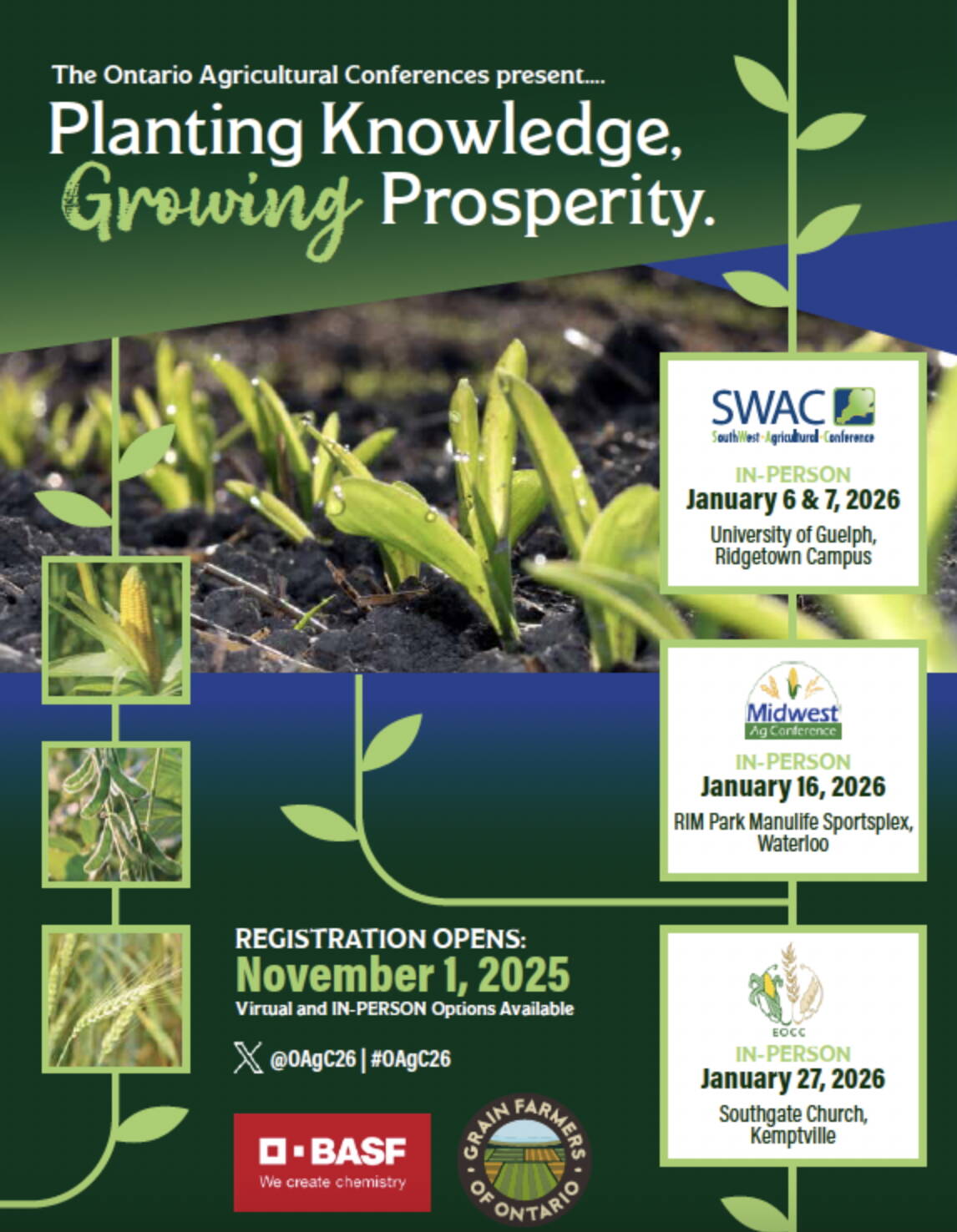World grain and oilseed markets are digesting logistical and fundamental changes due to the COVID-19 pandemic and historically low crude oil values.
The risk environment is unprecedented; commodity merchants are in a “learn as you go” frame of mind because trading conditions are changing on a daily basis. Ontario soybean and wheat prices are up sharply from two weeks ago while corn values are marginally lower. Western Canadian Select oil has been trading in a range of US$5/barrel to US$8 /barrel, which has kept the Canadian dollar near four-year lows.
Read Also

Registration open for Ontario Agricultural Conference
The Ontario Agricultural Conference 2026 offers in-person and online access to expert insights, hands-on learning, and networking opportunities.
Quick look
Soybeans: Chinese buying has helped move up soybean prices.
Corn: Ethanol market concern is pulling corn prices down.
Wheat: Major wheat exporters all having challenges.
The weaker resource-based currency has enhanced Ontario wheat and soybean prices; however, corn values are under pressure due to historically low ethanol prices.
China has stepped forward purchasing U.S. corn and hard red winter wheat over the past week. Wheat markets are also gaining traction due to logistical concerns in Europe where grain movement has slowed considerably. Loading delays have also been noted in South America due to additional measures to screen for COVID-19. The question regarding price has become secondary and with main concerns delivery timing. In times of crisis, nearby demand increases partially due to consumer hoarding; however, demand tends to fade longer term due to lower income levels.
The USDA will release its planting intentions report on March 31 and Statistics Canada will release Canadian intention on April 24. These are considered the most significant reports of the year because they will provide the first indication of the fundamentals for the 2020/21 crop year. The grain and oilseed markets will start to focus on seeding conditions while balancing demand considerations moving forward. Usually, we see the futures incorporate a small risk premium until seeding progress in Canada and the U.S. is over 50 per cent complete.
Soybeans
Chinese demand has surfaced for U.S. old crop soybeans, which has provided underlying support for the futures market. U.S. f.o.b. offers out of the Gulf are near Brazilian values. The competitive prices of U.S. beans along with a massive vessel lineup in Brazil has been a major driver of the U.S. soybean market.
The Brazilian soybean harvest is approximately 70 per cent complete, in line with the five-year average. Harvest selling pressure is easing while the currency trades near historical lows.
The Argentine harvest is in the early stages and will move into full steam over the next month. World soymeal values are also percolating higher largely due to stronger Chinese values. There are pockets in China that are short of beans and domestic Chinese soymeal prices have surged. Secondly, the soymeal market is likely incorporating a risk premium due to uncertainty in Argentina logistics.
Screening and quarantining vessel crews has potential to result in a vessel backlog. There are media reports that there are strikes at Argentinean ports but we don’t have this confirmed by the trade. U.S. meal values out of the Gulf remain at a premium to Argentina and Brazil, but this may change over the course of the next couple weeks.
In the short term, Ontario soybean prices are moving in line with the world market. During a crisis, there is usually an increase in demand in the short term followed by a very slow period. The market is now in the period of increased demand. Secondly, the futures market tends to incorporate a risk premium during the seeding period until the upcoming crop is more certain. Last year is fresh in traders’ minds.
The weaker Canadian dollar is also contributing to higher prices by making U.S. beans more expensive for the local crusher. Private trade forecasts are calling for a year-over-year increase in U.S. soybean acres. Prices for nearby delivery are up approximately 50 cents per bushel since early March. Once the soybean crop is seeded and well established, the market will come under pressure.
What to do: We’ve advised producers to be 80 per cent sold on old crop and 20 per cent sold on new crop. We’re planning to make our final sales recommendation during May or June.
Corn
Ontario corn prices are down approximately 20 cents a bushel from earlier in March for three main reasons. Domestic ethanol margins have deteriorated on both sides of the border due to the sharp drop in energy prices. Approximately 40 per cent of the U.S. corn is used for ethanol production and with margins deep in red ink, we’ll likely see plant closures in upcoming weeks.
Secondly, Ontario feedlot margins are deep in red ink. Cattle feeders are buying corn on a hand to mouth basis waiting for lower prices. Many feedlots are starting to sell fall placed calves and they’re not anxious to reload until the cattle market reflects profitability. Finally, export interest remains dead quiet with Ontario non competitive on the world market.
Overhanging the market is the growing supply scenario. U.S. corn acres were expected to be up four per cent to six per cent on the March 31 prospective plantings report. Using a trend-type yield, U.S. corn production has potential to finish near 393 million tonnes, up from the 2019 output of 348 million tonnes. Brazil’s Safrinha second crop corn seeding is approximately 90 per cent complete while the first crop harvest is nearing 60 per cent complete. The Argentine corn harvest is in full swing. Brazil’s crop is expected to finish at 101 million tonnes according to the USDA, unchanged from last year; the Argentine crop is expected to come in near 50 million tonnes, down marginally from the 2019 output of 51 million tonnes.
What to do: We’ve advised producers to be 80 per cent sold on old crop corn and 20 per cent sold on new crop. The market is in a very precarious situation going into spring planting.
We’re anticipating further downside longer term but the market will be quite volatile over the next month. For the market to experience further upside, we would need to see adverse conditions during the U.S. seeding period or a problem with Brazil’s second crop. At this stage, the corn market will function to encourage demand through lower prices given the increase in U.S. acreage.
Wheat
The COVID-19 pandemic has been positive for North American wheat prices. Ontario soft red winter wheat prices are up approximately 60 cents per bushel from earlier in March. All major exporters are contending with fresh issues over the past couple weeks.
According to Reuters, Russia suspended exports of processed grains from March 20 for 10 days. Earlier in March, there was no major concern that the Russian government would limit exports of any grains; however, this recent action has traders concerned that there could be an export duty or some type of intervention to curb wheat and barley exports.
Domestic prices have risen due to the sharp drop on the ruble and food inflation is a major concern in Russia and Ukraine. The Russian government advised the agriculture department and other officials to respond back by March 25 if there should be limitations on food.
In Australia, the currency dropped to a 17-year low. China has been a major buyer of sorghum, lifting the domestic feed market. The weaker Australian dollar has now made wheat competitive on the world market. Given the tighter supplies of wheat and barley, the domestic market needs to ration demand to a certain extent in some areas. Grain logistics haven’t been affected in the short term.
In Europe, grain logistics have slowed significantly. Train and truck movement has come to a halt in many areas and moving grain across borders is very difficult. Certain export terminals are operating as usual but others are shut down. Weekly domestic demand for flour and pasta has increased by two to three times across Europe as consumers stock up on supplies. Livestock producers are also asking for two or three weeks of feed supplies to ensure production capabilities. All these factors have strained the European system.
China has been a buyer of U.S. hard red winter wheat over the past week and there is potential for additional business of hard red winter and hard red spring. U.S. wheat exports are running ahead of last year and it appears the carryout will be down from earlier projections with this additional buying interest. Export sales have also improved to other destinations with the loading problems from other major exporters. Americans have also been stocking up on flour and pasta. It’s difficult to say how long this demand will last but basis levels have improved in an effort to enhance farmer selling.
In Ontario, the wheat market continues to ration demand by trading above world values. The weaker Canadian dollar has been a major factor driving the local market but we’ve also seen increased domestic demand as consumers stock up on food.
We’re expecting this increase in domestic demand to last about two to three weeks. At some point, consumers start to use stocked up supplies. Keep in mind that income levels will be down from approximately 60 per cent of Canadians and Americans because they work on hourly wages. No hours worked means no income.
What to do: We’ve advised producers to be 80 per cent sold on old crop and 20 per cent sold on new crop. The current situation makes it very difficult to forecast price activity. We’re planning to make our final sale later in May once the crop comes out of dormancy and is well established.















